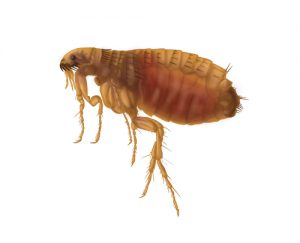What are snow fleas, and could they get on my pets?
By Chris Williams on February 1, 2011.
Q: What are snow fleas, and could they get on my pets?
A: That is a great question considering the weather we’ve been having in the Northeastern part of the country this winter.
Springtails, often called snow fleas, are some of the most primitive and populous insects on earth. Belonging to the Order Collembola, springtails have been found in fossil records dating back over 400 million years to the Devonian era. There are more than 500 species found in North America alone. Spring tails have evolved to fit into every ecosystem on the planet from Antarctica to the top of the Himalayas. They live in the rocky inter-tidal zone, on the surface of water, and on arctic ice. Some times large numbers will gather on the snow surface, hopping around, hence the name snow fleas. Springtails thrive in moist locations rich in organic matter, such as leaf litter and soil on the forest floor. In some places there can be more than 50,000 springtails per cubic foot of material.

Spring tails are very small, wingless insects usually 2mm in length or less. Most species we encounter are dark in color, with tiny antennae and eyespots. Small legs are used for general locomotion along with the furcula, or springtail, located below abdomen. It is this tiny spike that allows the collembolans to hop. When disturbed they may “spring” up and hop like fleas. Sometimes in the winter in New England, springtails will come up from the soil below the snow and be noticeable, sometimes in great numbers. Springtails feed on a variety of materials including fungi, mold spores, detritus, rotting vegetation to name a few. They have no interest in pets or people, however large numbers of any insect inside a home may indicate other problems that need to be addressed. Outside, springtails are everywhere, on patios, rocks, getting into pools, especially in leaves or under logs or boards. Occasionally springtails have been known to cover the side of a building. Springtails are very susceptible to desiccation and must spend most of their time in very moist locations. When conditions become unfavorable, such as flooding or lack of moisture, Springtails will move to a more suitable location. This search for the perfect living area may lead to an invasion of a structure, typically but not limited to damp cellar areas. Due to their small size, Springtails may enter under doors, cracks, and window screens. Once inside, they will usually be found in moist areas like bathrooms, in the bath tub, on damp window frames, cellar walls, and damp floors. Damp wall voids, house plant soil, or a build up of any organic material may contribute to Springtails infesting in a structure. Control of springtails usually involves altering the conditions that allow them to thrive. Lowering moisture and humidity, removing vegetation or other organic material that may feed or harbor springtails, and sealing cracks or openings in areas that may permit access in from the outside will aid in management of this common, harmless insect. A pest control professional can help identify areas of concern and make specific recommendations regarding your situation.